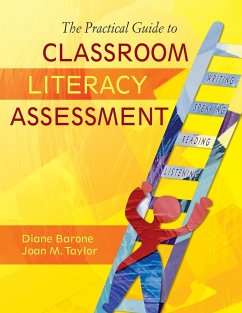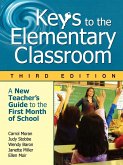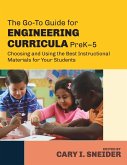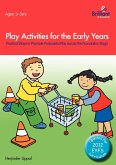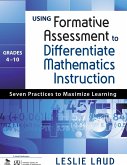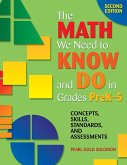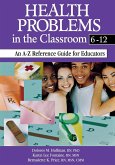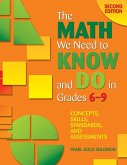- Broschiertes Buch
- Merkliste
- Auf die Merkliste
- Bewerten Bewerten
- Teilen
- Produkt teilen
- Produkterinnerung
- Produkterinnerung
Demonstrates practical ways to integrate assessments and instruction, and offers specific multiple assessment formats illustrated with rich examples, dialogues, scenarios, checklists, and student samples.
Andere Kunden interessierten sich auch für
![Keys to the Elementary Classroom Keys to the Elementary Classroom]() Janette MillerKeys to the Elementary Classroom40,99 €
Janette MillerKeys to the Elementary Classroom40,99 €![The Go-To Guide for Engineering Curricula, PreK-5 The Go-To Guide for Engineering Curricula, PreK-5]() Cary I. SneiderThe Go-To Guide for Engineering Curricula, PreK-539,99 €
Cary I. SneiderThe Go-To Guide for Engineering Curricula, PreK-539,99 €![Play Activities for the Early Years - Practical Ways to Promote Purposeful Play across the Foundation Stage Play Activities for the Early Years - Practical Ways to Promote Purposeful Play across the Foundation Stage]() Herjinder UppalPlay Activities for the Early Years - Practical Ways to Promote Purposeful Play across the Foundation Stage27,99 €
Herjinder UppalPlay Activities for the Early Years - Practical Ways to Promote Purposeful Play across the Foundation Stage27,99 €![Using Formative Assessment to Differentiate Mathematics Instruction, Grades 4-10 Using Formative Assessment to Differentiate Mathematics Instruction, Grades 4-10]() Leslie LaudUsing Formative Assessment to Differentiate Mathematics Instruction, Grades 4-1034,99 €
Leslie LaudUsing Formative Assessment to Differentiate Mathematics Instruction, Grades 4-1034,99 €![The Math We Need to Know and Do in Grades PreK-5 The Math We Need to Know and Do in Grades PreK-5]() Pearl Gold SolomonThe Math We Need to Know and Do in Grades PreK-543,99 €
Pearl Gold SolomonThe Math We Need to Know and Do in Grades PreK-543,99 €![Health Problems in the Classroom 6-12 Health Problems in the Classroom 6-12]() Dolores HuffmanHealth Problems in the Classroom 6-1248,99 €
Dolores HuffmanHealth Problems in the Classroom 6-1248,99 €![The Math We Need to Know and Do in Grades 6-9 The Math We Need to Know and Do in Grades 6-9]() Pearl Gold SolomonThe Math We Need to Know and Do in Grades 6-946,99 €
Pearl Gold SolomonThe Math We Need to Know and Do in Grades 6-946,99 €-
-
-
Demonstrates practical ways to integrate assessments and instruction, and offers specific multiple assessment formats illustrated with rich examples, dialogues, scenarios, checklists, and student samples.
Hinweis: Dieser Artikel kann nur an eine deutsche Lieferadresse ausgeliefert werden.
Hinweis: Dieser Artikel kann nur an eine deutsche Lieferadresse ausgeliefert werden.
Produktdetails
- Produktdetails
- Verlag: Corwin
- Seitenzahl: 194
- Erscheinungstermin: 4. Dezember 2006
- Englisch
- Abmessung: 280mm x 216mm x 11mm
- Gewicht: 503g
- ISBN-13: 9781412939140
- ISBN-10: 1412939143
- Artikelnr.: 21215489
- Herstellerkennzeichnung
- Libri GmbH
- Europaallee 1
- 36244 Bad Hersfeld
- gpsr@libri.de
- Verlag: Corwin
- Seitenzahl: 194
- Erscheinungstermin: 4. Dezember 2006
- Englisch
- Abmessung: 280mm x 216mm x 11mm
- Gewicht: 503g
- ISBN-13: 9781412939140
- ISBN-10: 1412939143
- Artikelnr.: 21215489
- Herstellerkennzeichnung
- Libri GmbH
- Europaallee 1
- 36244 Bad Hersfeld
- gpsr@libri.de
Diane M. Barone is Professor Literacy Studies at the University of Nevada, Reno. In her role at the university, she teaches courses in early literacy, diversity and literacy, and qualitative research. Her research interests center on young children, especially in high poverty schools, and how they develop in literacy. Her most current study followed 16 children from kindergarten through to Grade 6 to document their literacy growth. She has been an editor of Reading Research Quarterly and has written numerous articles, book chapters, and books. Some of her recent books include Reading First in the Classroom with Joan Taylor and Darrin Hardman, Literacy and Young Children: Research-Based Practices with Lesley Morrow, Teaching Early Literacy: Development, Assessment, and Instruction with Marla Mallette and Shelley Xu, and The National Board Certification Handbook. She is also Principal Investigator for Reading First in Nevada and serves as a member of the board for the International Reading Association.
Acknowledgments
About the Authors
Introduction
1. Assessments With a Focus on Learning: Purposes and Promises
The Historical Root of the Matter
Which Literacies?
Audiences and Types of Assessments
Timing of Tests
Reasons for Assessments
Final Thoughts
2. Writing Assessments
Brief Historical Overview of Writing Assessments
Writing Assessments Today
Types of Writing Assessments
Writing Tasks
Evaluation Tools
Writing Assessment Formats
Assessing Processes
Assessing Products
Organizing and Administering Your Own Scoring Session
Final Thoughts
3. Reading Asessment
Teacher-Created Assessments
Commercial Assessments
Ongoing Assessments Used to Monitor Progress
End-of-Year Assessment
Final Thoughts
4. Oral and Visual Assessments
Speaking
Listening
Viewing and Experiencing
Audience and Purpose
Importance of a Variety of Assessment
Forms and Products
Final Thoughts
5. Assessment Portfolios
What Is an Assessment Portfolio?
What Are the Issues Surrounding Portfolios?
Final Thoughts
6. Putting Assessment in Perspective
Overview of Assessment Data
Uses of Assessment
A Few Final Assessment Caveats
Additional Resources for Assessment
Final Thoughts
Index
About the Authors
Introduction
1. Assessments With a Focus on Learning: Purposes and Promises
The Historical Root of the Matter
Which Literacies?
Audiences and Types of Assessments
Timing of Tests
Reasons for Assessments
Final Thoughts
2. Writing Assessments
Brief Historical Overview of Writing Assessments
Writing Assessments Today
Types of Writing Assessments
Writing Tasks
Evaluation Tools
Writing Assessment Formats
Assessing Processes
Assessing Products
Organizing and Administering Your Own Scoring Session
Final Thoughts
3. Reading Asessment
Teacher-Created Assessments
Commercial Assessments
Ongoing Assessments Used to Monitor Progress
End-of-Year Assessment
Final Thoughts
4. Oral and Visual Assessments
Speaking
Listening
Viewing and Experiencing
Audience and Purpose
Importance of a Variety of Assessment
Forms and Products
Final Thoughts
5. Assessment Portfolios
What Is an Assessment Portfolio?
What Are the Issues Surrounding Portfolios?
Final Thoughts
6. Putting Assessment in Perspective
Overview of Assessment Data
Uses of Assessment
A Few Final Assessment Caveats
Additional Resources for Assessment
Final Thoughts
Index
Acknowledgments
About the Authors
Introduction
1. Assessments With a Focus on Learning: Purposes and Promises
The Historical Root of the Matter
Which Literacies?
Audiences and Types of Assessments
Timing of Tests
Reasons for Assessments
Final Thoughts
2. Writing Assessments
Brief Historical Overview of Writing Assessments
Writing Assessments Today
Types of Writing Assessments
Writing Tasks
Evaluation Tools
Writing Assessment Formats
Assessing Processes
Assessing Products
Organizing and Administering Your Own Scoring Session
Final Thoughts
3. Reading Asessment
Teacher-Created Assessments
Commercial Assessments
Ongoing Assessments Used to Monitor Progress
End-of-Year Assessment
Final Thoughts
4. Oral and Visual Assessments
Speaking
Listening
Viewing and Experiencing
Audience and Purpose
Importance of a Variety of Assessment
Forms and Products
Final Thoughts
5. Assessment Portfolios
What Is an Assessment Portfolio?
What Are the Issues Surrounding Portfolios?
Final Thoughts
6. Putting Assessment in Perspective
Overview of Assessment Data
Uses of Assessment
A Few Final Assessment Caveats
Additional Resources for Assessment
Final Thoughts
Index
About the Authors
Introduction
1. Assessments With a Focus on Learning: Purposes and Promises
The Historical Root of the Matter
Which Literacies?
Audiences and Types of Assessments
Timing of Tests
Reasons for Assessments
Final Thoughts
2. Writing Assessments
Brief Historical Overview of Writing Assessments
Writing Assessments Today
Types of Writing Assessments
Writing Tasks
Evaluation Tools
Writing Assessment Formats
Assessing Processes
Assessing Products
Organizing and Administering Your Own Scoring Session
Final Thoughts
3. Reading Asessment
Teacher-Created Assessments
Commercial Assessments
Ongoing Assessments Used to Monitor Progress
End-of-Year Assessment
Final Thoughts
4. Oral and Visual Assessments
Speaking
Listening
Viewing and Experiencing
Audience and Purpose
Importance of a Variety of Assessment
Forms and Products
Final Thoughts
5. Assessment Portfolios
What Is an Assessment Portfolio?
What Are the Issues Surrounding Portfolios?
Final Thoughts
6. Putting Assessment in Perspective
Overview of Assessment Data
Uses of Assessment
A Few Final Assessment Caveats
Additional Resources for Assessment
Final Thoughts
Index

